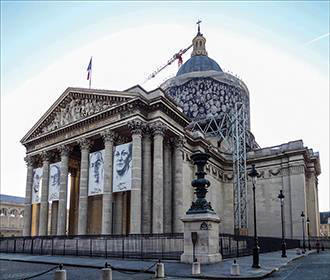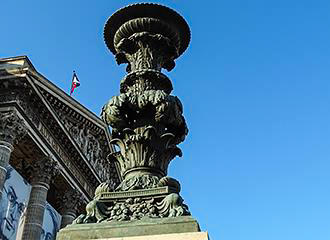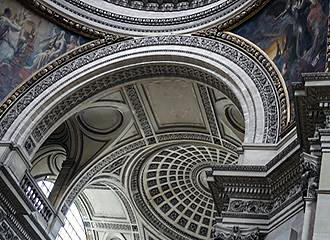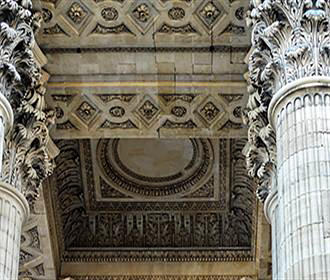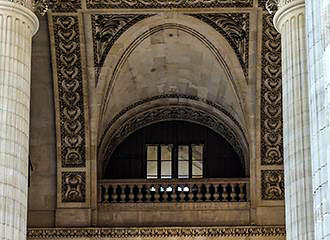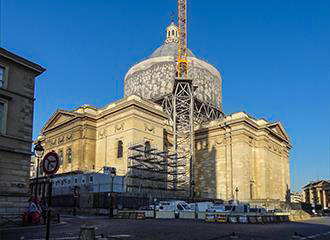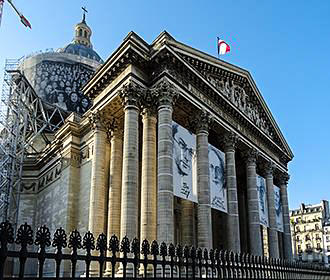History of The Pantheon in Paris
The Pantheon is located in the Latin Quarter of Paris and over the years has become a famous burial place with many famous and influential people having been entombed here, but it is far more than that, as it was one of the most important architectural achievements of its time and is one of the great neoclassical monuments in Paris today.
Origins of the Pantheon
When King Clovis converted to Christianity, he decided to build a basilica on the very site where The Pantheon stands today, which was back in the year 507AD.
Saint Genevieve, who was the patron saint of Paris and protected the city from the barbarians, was buried in this basilica in 512AD and hence why the basilica and further churches were dedicated to Saint Genevieve.
By the 1700s people were still saying prayers to Saint Genevieve and in 1744 after King Louis XV had been seriously ill, he attributed his recovery to the prayers of Saint Genevieve and decided that he would have a prestigious church built on the same spot as the original basilica, which would of course be dedicated to her.
Yet this massive project was also undertaken to further the political agenda of King Louis XV and also to try and restore the prestige of a divided church.
And so, in 1755 the design for the new basilica was entrusted to Jacques-Germain Soufflot, who was the chief architect under King Louis, and his ambition was to build an even more impressive basilica than the Church of saint Peter in Rome, which is where he got his inspiration from.
The overall design was that of a Greek cross with a very impressive portico of Corinthian columns and was to be a vast building that would be 100 metres long by 84 metres wide and an incredible 83 metres high.
But the actual Pantheon has a combination of different styles like Greek architecture and also a Gothic system that utilised flying buttresses and arches to make it as light as possible and there were 45 clerestory windows to flood the building with light, although these were blocked up during the French Revolution.
Jacques Soufflot also drew up plans for a monumental square and a law school was built opposite the church between 1771 and 1783, which was then followed by a school of theology.
However, even though the first foundations were laid in 1758, unfortunately, due to financial difficulties, Jacques Soufflot died before this impressive basilica was completed and so, his architect pupil and associate Jean-Baptiste Rondelet completed it in 1790 at the start of the French Revolution.
But then in 1791, the basilica was turned into a National Pantheon, as the Constituent Assembly wanted a fitting resting place for the nations great men, people such as Honore Gabriel Riqueti Comte de Mirabeau, who was the President of the Constituent Assembly.
In 1791 during the French Revolution, Francois-Marie Arouet de Voltaire, who was a philosopher and enlightenment writer, was also buried in the Pantheon and then in 1794 Jean-Jacques Rousseau, who was a writer and composer of operas, along with Jean-Paul Marat, who was a writer, political theorist and journalist, were also buried in the Pantheon.
In fact, Jean-Jacques Rousseau, who was known as the father of equality, is laid to rest opposite his sworn enemy, Voltaire, but these two men were both named as emblems of the Enlightenment, which was a term used for philosophers who favoured reason and science.
But when you look at the history of Paris, it is quite surprising how many things changed with political influences of the time and when the political thoughts changed, the ashes of Mirabeau and Marat were removed.
Yet the history of the Pantheon still continues, and it became home of Christian worship once again, even though people were still interred here, but by the reign of Napoleon Bonaparte I, it changed back to being a Pantheon again, rather than a place of worship. In fact, it was the emperor Napoleon I that commissioned the Arc de Triomphe in Paris, yet is now buried within Les Invalides, where you can still get to see the Tomb of Napoleon today.
And in 1851 physicist Leon Foucault demonstrated the rotation of the Earth by his experiment conducted in the Pantheon, by constructing a 67 metre Foucault pendulum beneath the central dome.
This original iron sphere from the pendulum was returned to the Pantheon in 1995 from the Musee National des Arts et Métiers, while this museum in Paris was undergoing renovations, but it was returned to the museum and a copy of the pendulum is in place at the Pantheon today.
Plus, when you look at the history of the Eiffel tower, there was even a Faucoult’s pendulum installed there as well, and this is one piece of science apparatus that has been used throughout the world to demonstrate the rotation of the earth.
Now we mentioned earlier that the windows were blocked up during the French Revolution in the late 1700s, and from 1874 there were paintings on canvas called maroufle that were added where the windows that had been bricked up in 1792 and 1793. And this was done during a period when the Pantheon reverted back to a church for a while.
The Pantheon Burial Place
The basilica was turned back to a Pantheon as Napoleon continued to inter great people into the crypt, and after the death of Victor Hugo, through public reaction, he was also interred in the Pantheon in 1885. In fact, Victor Hugo, who is famous for the novels Les Miserables and the Notre Dame de Paris, which in English is known as the Hunchback of Notre Dame lived in Paris and today you can get to see the Maison Victor Hugo museum in Paris.
And since that time, many influential citizens of Paris have been interred here, such as French presidents, scientists like Pierre and Marie Curie for their work on radium and she was only the second women to be interred in the Pantheon. There is also the heart of Leon Gambetta in an urn, along with Resistance fighters like Jean Moulin whose ashes were transferred from the Pere Lachaise Cemetary, Louis Braille whose body was moved to the Pantheon on the centenary of his death and many more that have been buried at this fabulous monument in Paris.
But one of the most recent people to be interred in the Pantheon is Alexandre Dumas and although he was originally buried in the place of his birth because he was of mixed race and this was not considered acceptable at the time, the French President, Jacques Chirac, had his body exhumed in 2002, which was over 130 years after his death, stating that an injustice had been corrected with the proper honouring of one of the great authors from France.
Now you may be wondering who this person was.. Alexandre Dumas, was a novelist and two of his most famous works were the Count of Monte Cristo and the Three Musketeers, and in the solemn procession that was televised, his coffin was covered in a blue velvet with the Three Musketeers motto of All for one, and one for all. And the Republican Guards carrying the coffin were dressed as the Musketeers to take him to his final resting place at the Pantheon, to be alongside other famous writers like Victor Hugo. Also, since 1994, the home Alexandre Dumas had built, called the Chateau de Monte Cristo just outside of Paris in the Ile de France region, is now a museum that is open to the public.
